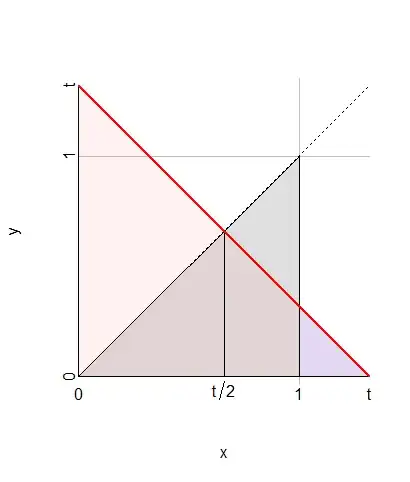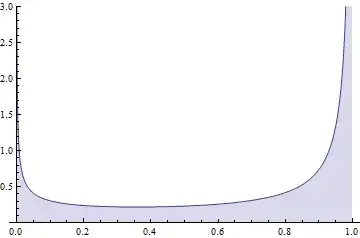It is important to keep track of where the densities are zero. Drawing a picture helps immensely.
When $X$ has a uniform distribution on $[0,1]$ (with density $f_X(x)=1$ on that interval, $0$ elsewhere) and $Y,$ conditional on $X,$ has a uniform distribution on $[0,X]$ (therefore with density $f_{X\mid Y}(y\mid x)=1/x$ on that interval and $0$ elsewhere) then
The support of $(X,Y)$ is the triangle $\Delta$ defined by the X-axis, the line $X=1,$ and the line $Y=X.$
On the triangle $\Delta$ the joint density is $$h(x,y) = f_{X\mid Y}(y \mid x) f_X(x) = \frac{1}{x}$$ and elsewhere $h$ is zero.
Note that the conditional CDF is just as readily obtained as
$$\Pr(Y \le y \mid X) = \left\{\matrix{1& y \ge X \\ \frac{y}{X} & 0 \le y \le X}\right.$$
The CDF of $T=X+Y$ at any value $t$ can be found by integrating over the values of $X$ and breaking that into three regions marked by the endpoints $t/2,t,0$ and $1:$
$t/2$ is a key point because when $X\le t/2,$ $Y$ can have any value between $0$ and $t/2,$ but when $X\gt t/2,$ $Y$ is limited to the range $[0,t-X],$ where it has probability $(t-X)/X.$
$t$ is a key point because it is impossible for $X$ to exceed $t$ when $X+Y=t.$
$0$ and $1$ are key points because they delimit the support of $X.$

In this figure, $\Delta$--the support of $(X,Y)$--is the gray triangle. The region $X+Y\lt t$ below and to the left of the red line is shaded red. The integration is carried out for $x$ from $0$ to $t,$ covering the triangle of base $t$ and height $t/2.$ That triangle consists of two equal halves, from which the blue portion at the right from $1$ to $t$ is subtracted.
Thus
$$\eqalign{
\Pr(X+Y\lt t) &= \Pr(Y \le t-X) = E[\Pr(Y\le t-x) \mid X=x] \\
&= \int_0^{t/2} 1\mathrm{d}x + \int_0^t \frac{t-x}{x}\mathrm{d}x + \int_t^1 \frac{t-x}{x}\mathrm{d}x \\
&= \left\{\matrix{t\log 2 & t \le 1 \\ t\log 2 + t - 1 - t\log t & 1 \lt t \le 2.}\right.
}$$
Differentiating with respect to $t$ yields the density of $T$, given by $f_T(t)=\log 2$ when $0\le t \lt 1$ and by $f_T(t)=\log 2 - \log t$ for $1 \lt t \le 2.$
Here, as a check, is a graph of this $f_T$ superimposed on a histogram of ten million iid realizations of $X+Y:$

The R code used to produce this simulation is clear and swift in execution:
n <- 1e7
x <- runif(n)
y <- runif(n, 0, x)
z <- x+y
hist(z, freq=FALSE, breaks=100, main="Density of T", xlab="T")
curve(ifelse(x <= 1, log(2), log(2/x)), col="Red", add=TRUE, lwd=2)

